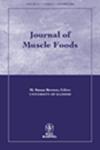A total of 324 swab samples were collected from organized slaughterhouses and retail outlets at various processing steps from poultry carcasses, and the samples were processed for total viable counts (TVCs) and differential counts. The TVCs (log10 cfu/cm2 ± standard error) in organized slaughterhouses at different processing steps were found to be 5.18 ± 0.09 after shackling, 5.24 ± 0.15 after bleeding, 3.95 ± 0.14 after scalding and defeathering, 5.26 ± 0.15 after evisceration and 4.98 ± 0.17 after cutting, while the same in retail outlets were 6.63 ± 0.21 before slaughter, 7.29 ± 0.20 after bleeding, 6.53 ± 0.24 after removal of skin with feathers, 7.24 ± 0.26 after evisceration and 7.40 ± 0.22 after cutting, respectively. Analysis of variance for TVC during different steps in both revealed highly significant differences (P < 0.01). Also, the contamination during various steps varied significantly. The differential counts revealed that Escherichia coli was predominant in all processing steps in organized slaughterhouses, whereas Staphylococcus aureus, E. coli and Clostridium spp. were present in all steps in retail outlets. Twenty samples in retail outlets showed the presence of Salmonella spp. The average prevalence of all organisms isolated during various processing steps in organized slaughterhouses and retail outlets are 9.13 and 82.21% S. aureus, 0 and 47.49% Bacillus cereus, 14.99 and 39.23% Clostridium spp., 17.46 and 81.52% E. coli, and 0 and 10.55% Salmonella spp.
The study concluded that retail outlets showed highest bacterial counts as well as maximum number of isolates as compared with organized slaughterhouses. Bacillus cereus and Salmonella spp. were absent in hygienically processed carcasses. Evisceration, as well as scalding and defeathering, was found to be the critical operations in organized slaughterhouses, while cutting, bleeding, evisceration and removal of skin with feathers were noted as the critical operations in retail outlets. The presence of pathogenic microbes on poultry carcasses in organized slaughterhouses and retail outlets delineates the different hazards to the consumers from such pathogens and the need for a comprehensive quality assurance program especially in small poultry slaughtering and dressing units to ensure safe and wholesome meat to consumers.


